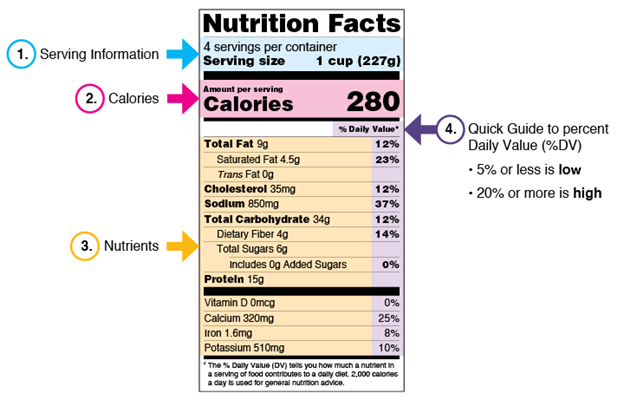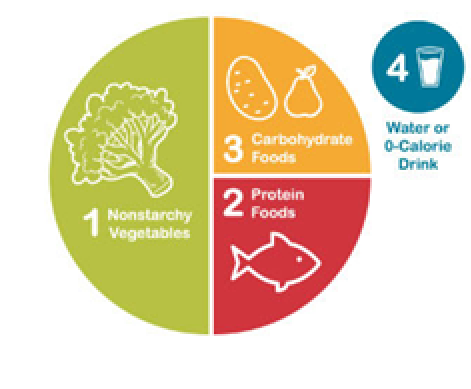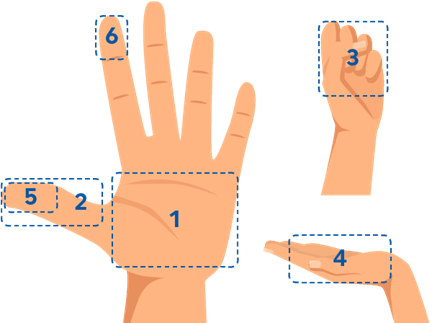If you have diabetes or prediabetes it is important to manage your blood sugar. Eating smart can prevent or delay diabetes. Knowing what to eat and how much to eat each time you have a meal or snack is important for managing your blood sugar.
Meal planning, counting carbs, reading nutrition labels, using the plate method, and watching portion sizes are helpful ways to keep your blood sugar in check and get the nutrition you need to be healthy.
What are carbohydrates (carbs)?
There are three main nutrients found in foods: carbs, protein, and fat. Carbs are broken down in your body to glucose (sugar), which is broken down by your cells and organs for energy. When you have too many carbs at one time, it can lead to high blood sugar. There are three types of carbs: sugars, starches, and fiber.
Sugars: This is the most simple form of carbs. It is found as added sugar in regular soda, candy, and baked goods or as naturally occurring sugar for example in fruits and milk.
Starches: These are more complex carbs and are made of simple sugars strung together. Starches include grains like bread, rice, pasta, and starchy vegetables including corn, green peas, and potatoes.
Fiber: Fiber is a complex carb. Your body cannot break down fiber. It helps you to feel full and helps your gut work. For example, helping prevent constipation. Some examples of foods high in fiber are fruits, beans, and grains.
What types of carbs should I eat?
Some tips for types of carbs to eat are listed below.
Aim for whole grains instead of refined grains, for example, whole wheat bread, rice, or pasta instead of white bread, rice, or pasta.
Eat foods high in fiber; be sure to read the nutrition facts label to see how much fiber is in foods.
Limit your added sugar intake. Added sugar is commonly found in regular soda, baked goods, candy, and other processed foods. The amount of added sugar can also be found on the nutrition facts label.
A registered dietitian can help make a meal plan that works for your lifestyle, preferences, and medications. A dietitian can also teach you about counting carbs and using the plate method.
Ask your healthcare provider to refer you to a registered dietitian or visit eatright.org to find a registered dietitian in your area.
Reading a Nutrition Facts Label 
It is important for managing your diabetes to understand what you are looking at on a nutrition facts label. Here are some key tips to remember:
Calorie and nutrients are listed next. When managing your diabetes, it is important to look at the total carbohydrate (carbs) line. Food high in carbs will raise your blood sugar more. Underneath the total carbohydrate (carb) lists the types of carbs: dietary fiber, total sugars, and added sugars. Choose foods with lower amounts of saturated fat, sodium, and added sugar.
Meal Planning
There are different ways to help you eat healthy with diabetes or prediabetes.
Carbohydrate (Carb) Counting
Carb counting is a way to help you keep track of the amount of carbs you have in a day. Carbs are measured in grams. 1 carb serving = 15 grams of carbs. The amount of carb servings per meal will vary per person and depends on your age, weight, activity level, and some additional factors. A registered dietitian can help make a meal plan with the amount of carbs per meal or snack that works for your lifestyle and with your medications.
The Plate Method
The Plate Method is a simple way to remember what foods to put on your plate. It is suggested to use a 9 or 10-inch plate. The goal is to eat different types of foods for each meal or snack. Here is the breakdown of the Plate Method:

Fill ½ of your plate with non-starchy vegetables. Non-starchy vegetables are high in vitamins, minerals, and fiber, but are low in carbs so they will not raise your blood sugar as much as other foods. Some examples include broccoli, asparagus, carrots, cucumber, green beans, and leafy greens.
Fill ¼ of your plate with lean protein foods. Protein foods that come from animal sources can be high in saturated fat which can increase your risk of heart disease. Try to choose lean protein foods. Examples of lean protein foods include chicken and turkey without the skin, eggs, fish, and lean cuts of beef. Examples of plant-based protein foods are tofu, nuts and nut butters, beans, and lentils.
Fill ¼ of your plate with carbohydrate (carb) foods. These foods will affect your blood sugar the most, which is why it is important to fill only a quarter of your plate with them. Examples of carb foods are grains, starchy vegetables (corn, green peas, potatoes), fruit, beans and legumes, yogurt, and milk.
Choose water or a low-calorie drink. Regular soda, sweet tea, and energy drinks can add extra calories and added sugar to your day. You want to choose water or other low-calorie drinks instead. Some examples include unsweetened iced tea, sparkling water, and flavored water with zero sugar.
Plate Method Image Source: Centers for Disease Control and Prevention (CDC), Diabetes Meal Planning, Reviewed 4/19/2023. https://www.cdc.gov/diabetes/managing/eat-well/meal-plan-method.html*
Portion Size vs. Serving Size
Portion size is the amount of food you choose to eat. Serving size is a specific amount of food, such as 8 oz. or 1 cup. Portion size and serving size are not always the same. It is a good idea to have measuring spoons/cups to see what the actual serving size is of a certain food. The Plate Method is a good way to estimate your portion size by looking at a 9 or 10-inch plate and filling half with non-starchy vegetables, a quarter with lean protein foods, and a quarter with carbohydrate (carb) foods.
Another way to estimate portion size is by using your hand.

The size of your palm (no fingers) is about 3 oz or the suggested size of lean protein.
The size of your thumb (tip to base) is about 1 ounce, the suggested amount of cheese.
The size of your fist is about 1 cup, which is a serving size of cooked vegetables.
The size of your cupped hand is about 1-2 ounces, the suggested size of nuts or pretzels for a snack.
The size of your thumb (tip to 1st joint) is about 1 tablespoon, the suggested amount of nut butters is 2 tablespoons.
The size of the tip of your finger is about 1 teaspoon.
For examples of the difference between portion size and serving size, visit the Academy of Nutrition and Dietetics.
Image Source: Centers for Disease Control and Prevention (CDC), Diabetes Meal Planning,
Portion Control: https://www.cdc.gov/diabetes/managing/eat-well/meal-plan-method.html
Next Steps
What can you do to eat smart with the Plate Method?
To start using The Plate Method, first learn which kinds of foods are suggested. At a meal, look at your plate and ask yourself:
“Do I have any non-starchy vegetables on my plate?”
“Are there any protein foods?”
“Are there any carbohydrate (carb) foods?”
Once you can name which kinds of foods are on your plate, think about what is missing. Ask yourself:
“Is half of my plate non-starchy vegetables?”
“Do I have a quarter of my plate with carbohydrate (carb) foods?” Etc.
If you are missing one of the pieces of the Plate Method, start there to make small changes. For example, maybe you are filling half of your plate with rice, a carb food, and only a quarter of your plate with broccoli, a non-starchy vegetable. Make a goal for the next time you have a meal to try to have less rice and more broccoli.
Finding a National Diabetes Prevention Program or
Diabetes Self-Management Education and Support Program
There are resources in Maryland to help you on your journey to decreasing your risk of type 2 diabetes or managing your type 2 diabetes. Find classes in Maryland here. Talk to your healthcare provider to refer you to a registered dietitian for a meal plan specific to your needs.
Finding Healthy Foods in Your Area
Need help finding healthy fruits and vegetables? Visit the Maryland Food Bank webpage to search for a food pantry near you or visit the SNAP benefits webpage to learn more about their benefits. Visit the Maryland Farmer’s Market webpage to learn more about their programs and to find a Farmer’s Market in your area.

